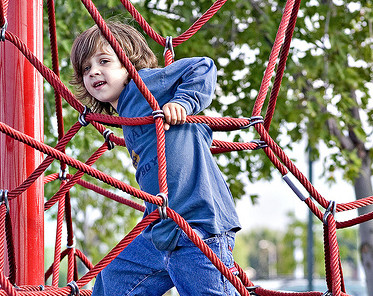Why It’s A Good Idea To Let Your Kids Be A Little Risky

I grew up on my neighborhoods’ playgrounds. My parents both worked full time, and I lived on military bases for most of my childhood. This meant that I was never short of friends to play with, and I usually didn’t have an adult guardian looking after me. Instead, my little brother became my sidekick, and we would explore the area surrounding our childhood home.
We would build forts in the cleared-out drainage pipes under the train tracks behind our house, or we would climb trees with our friends. We both suffered pretty terrifying crashes on our bikes, and sometimes we stayed out a little later than dinnertime.
But we were fine. We never suffered life-threatening injuries, and we never wandered so far from home that we got lost. We found our way around, and we learned how to count on each other.
Looking back, I’m extremely grateful for my childhood. I have friends whose 13-year-old younger siblings have probably never climbed a tree or built a fort outside. Instead, they get most of their entertainment from video games.
Too often, when I asked a friend how old their younger sibling is, they say 12 or 13 when I expected them to say no more than 10. Their younger siblings seem overly-coddled and afraid of risk, and that fear makes me sad for them.


Studies have shown that risk is actually good—some would say necessary—for children. A statement this summer from the International Journal of Environmental Research and Public Health said that children need “risky play,” which includes climbing and jumping from a high place, playing with tools, playing outside where there is potential for getting lost and playing near dangerous elements, according to The Guardian.
This risky play increases children’s physical activity, social health and their ability to self-regulate emotions such as anger and fear in the face of risk.
And—possibly one of the most important benefits of letting your children take risks—it helps build their resilience, according to The Washington Post. When you consider that children are 10 times more likely to be killed in a car accident than be abducted by a stranger, it seems silly not to allow your children to be more risky, according to Business Insider.
Risk helps build character, but, as Lauren Night from the Post notes, it also just makes childhood more fun. Here are a few suggestions from Knight and The Guardian to let your children be a little more risky.
1. Let Them Use Real Tools
Knight suggests teaching your child to use real tools, because why not? Then, once you’ve taught her to use a hammer correctly, stand back and let her try to hammer a few nails through a stamp on a wall or a piece of wood. Trusting your child to complete something risky will teach her a lot.


2. Encourage Them To Play Outside And Climb Trees
Let your children climb trees! I’ve climbed more than a dozen trees in my life and have never been seriously hurt; the odds are slim. And when you’re kids are outside, try to back off a little. Don’t regulate how they’re climbing something or how high they’re swinging.
Just let them take the risk. Mark Tremblay, who authored the International Journal’s position statement on risk this summer, suggests allowing your children to wander around on their own for 20 minutes, according to the Guardian.
3. Gradually Give Your Child More Freedom
Knight suggests giving your child more freedom as he grows and gains confidence. For example, start by supervising him a bit less on the playground. Then, eventually, maybe you can let him ride to the local playground on his bike a few minutes ahead of you. “With greater risk comes greater responsibility,” Knight wrote. “Your child will understand this.”
4. Let The Play Be A Little Unpredictable
Knight calls this “open-ended play,” and she wrote that it allows for “out-of-the-box exploration.” And I totally agree. Building forts in an empty drainage pipe under railroad tracks probably wasn’t by-the-rules outdoor play, but it encouraged me and my younger brother to get creative. And, when something went wrong with our open-ended play, we learned to solve it ourselves.


Photo by chefranden

